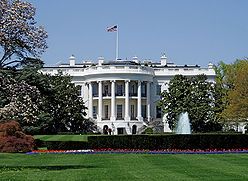This is your morning Open Thread. Pour your favorite beverage and review the past and comment on the future.
Find the past “On This Day in History” here.
October 13 is the 286th day of the year (287th in leap years) in the Gregorian calendar. There are 79 days remaining until the end of the year.
On this day on 1792, the cornerstone for the White House in laid in Washington, DC.
In 1800, President John Adams became the first president to reside in the executive mansion, which soon became known as the “White House” because its white-gray Virginia freestone contrasted strikingly with the red brick of nearby buildings.
The President’s house was a major feature of Pierre (Peter) Charles L’Enfant’s’s plan for the newly established federal city, Washington, D.C. The architect of the White House was chosen in a design competition, which received nine proposals, including one submitted anonymously by Thomas Jefferson. The nation’s first president, George Washington, traveled to the site of the federal city on July 16, 1792, to make his judgment. His review is recorded as being brief, and he quickly selected the submission of James Hoban, an Irishman living in Charleston, South Carolina. Washington was not entirely pleased with the original Hoban submission, however; he found it too small, lacking ornament, and not fitting the nation’s president. On Washington’s recommendation, the house was enlarged by thirty percent; the present East Room, likely inspired by the large reception room at Mount Vernon, was added.
Construction
Construction of the White House began with the laying of the cornerstone on October 13, 1792, although there was no formal ceremony. The main residence, as well as foundations of the house, were built largely by enslaved and free African-American laborers, as well as employed Europeans. Much of the other work on the house was performed by immigrants, many not yet with citizenship. The sandstone walls were erected by Scottish immigrants, employed by Hoban, as were the high relief rose and garland decorations above the north entrance and the “fish scale” pattern beneath the pediments of the window hoods. The initial construction took place over a period of eight years, at a reported cost of $232,371.83 ($2.8 million in 2007 dollars). Although not yet completed, the White House was ready for occupancy on or circa November 1, 1800.
Shortages, including material and labor, forced alterations to the earlier plan developed by French engineer Pierre Charles L’Enfant for a “palace” that was five times larger than the house that was eventually built.] The finished structure contained only two main floors instead of the planned three, and a less costly brick served as a lining for the stone facades. When construction was finished the porous sandstone walls were coated with a mixture of lime, rice glue, casein, and lead, giving the house its familiar color and name.
As it is a famed structure in America, many replicas of the White House have been constructed.


Recent Comments